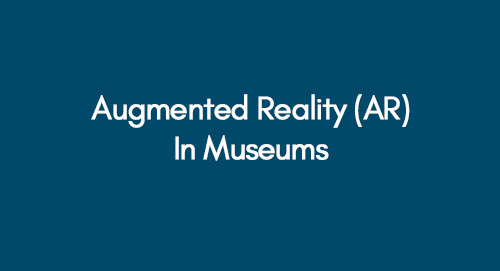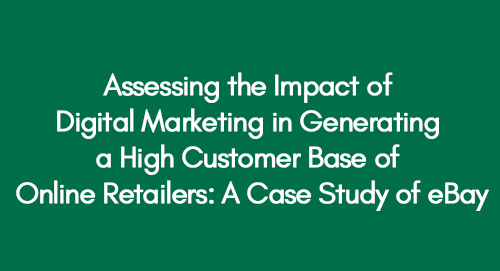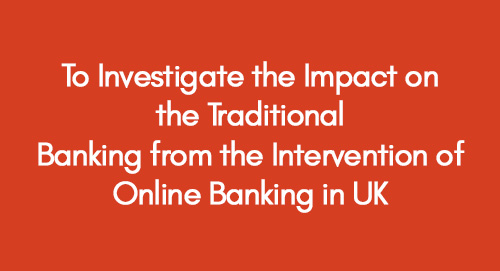
To Investigate the Impact on the Traditional Banking from the Intervention of Online Banking in UK
January 14, 2021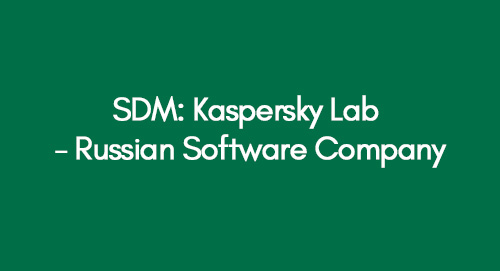
SDM: Kaspersky Lab – Russian Software Company
January 14, 2021Introduction
In the contemporary world, the importance of technology is being enhanced in providing the best experiences to tourists. For instance, airlines are providing luxury travelling experience. For the tourism industry; the development of technology provides ease of travelling, ease of accommodation and stay in the desired resorts within a tourist package (Chung et al, 2015). Students use telecommunication and communication devices for the purpose of the study. Manufacturing facilities also use technologies for reducing wastages from operations. Similarly, technology is important for every sector of the world (Brida et al, 2013).
From the viewpoint of (Zhou and Teo, 2017) Information and Communication Technology (ICT) refers to the interface that involves communication and telecommunication. ICT provides the infrastructure that enables users to transfer information using communication devices. As mentioned above, technological development is necessary for every field of life, museums are also developing with technological advancement in order to attract tourists (Jung et al, 2016). This report is going to discuss a start-up idea of Augmented Reality (AR) in museums. The report has discussed the target market for this technology, sector size, level of implementing technology and business process for technology. Moreover, it has included the start-up details and usefulness of technology in museums. It has also included student reflection for AR.
Background
Technological development is the need of today’s businesses. The business idea in this report is Speaking Celt in AR. Following is the characteristics of the target market which can benefit start-up for Augmented Reality application as the Speaking Celt.
Characteristics of Target Market for AR
The target for AR should be a sector that can invest heavily. This application requires intensive capital. Museums in United Kingdom (UK) are able to spend huge money for the development of technologies (Ciecko, 2018). The customers would like to visit museums with the creativity and advancement in the technology. Visitors will find it adorable if they find an experience of storytelling of the history with the 3 Dimension (3D) effects of the object. There 2,500 Museums in UK (Museum Association, 2018). The segments of museums are divided in several parts. They are explained briefly:
|
Geographic |
Demographics |
Psychographic |
Behavioral |
|
Natives: Native people would like to visit museum with their children so that they and their children can get knowledge of the culture and history of the UK (McIntyre, 2013; Ament, 2013).
|
Gender: Male and females both visits museum 50/50 per cent in UK (Museum Next, 2018, Brida et al, 2013). |
Businessmen like to visit museums when they come with their families (McIntyre, 2013). |
Lifestyle: People who have some relatives in the other region they also like to visit several places, hence, if they hear about an amazing place to visit they like to visit the place (Brida et al, 2013; McIntyre, 2013).
|
|
International tourists: There are multicultural people resides in the UK. They would like to visit the museum where history is being told using AR technology. Moreover, international tourists would also admire to visit the museum with an adorable advancement of technology (McIntyre, 2013; Ament, 2013).
|
Age: Visitors of more than 55 are the targeted age for Museum (Museum Next, 2018, Brida et al, 2013) |
Retired people are interested to travel for a peaceful environment. This is why they are also targeted for museum (Brida et al, 2013). |
|
Type of ownership
Technology is one of the important parts of the businesses. It provides ease of accomplishing tasks. Furthermore, it gives innovation in the businesses. Similarly, technology of AR can bring innovation to the museums. However, technology has been vulnerable to implement in the organizations. In this situation, the business ownership of company will face different challenges when it will implement AR technology. Such as:
- In technological devices or systems, it is required to update each and every device. If devices will not be checked on the regular basis then it may cause hazardous situation for organization.
- Another problem in the ownership is to manage installation of the devices. The AR system requires accuracy and security for the organization Hence, it may cause hurdle to the organization if there will be inadequate installation of the data security.
- Data security is also a huge problem for an ownership. Data security system should be strong and updated so that no data can be leaked.
- Another feature of AR in museums is to provide applications in the devices of visitors with which they can create an image using their smartphones. They can create the objects of the museum in 3 dimensions wherever they want (Wang et al, 2017).
Technology Is Aiming To Support/Improve
The museums can be the best target sector for this application. Museums are encouraging the implementation of digital technology for virtual audio and visual effects. There are different forms of virtual creations for the avatars in a Museum. It can be in the form of an application or it can be a system that will provide Speaking Celt (Jorner, 2017). With the benefits of AR, a technology museum will get several benefits.
Start-Up Details
Entrepreneurial concept
The idea is for improving museum facilities with the use of Speaking Celts in AR. Following are the characteristics of AR, market gap, changes using new technology in museums and target sector for AR has discussed:
Technology characteristics
Augmented Reality is a useful invention of technology. Its implementation in the museum is increasing in this era. There are different forms of AR; it is in the different forms with which customers can get pleasant experience (Hsiao et al, 2016). AR is the layers for generating computer image in order to enhance the real-world experience (Dunleavy and Dede, 2014). It enables customers to discover details of the history in a museum either it is a word, letter or punctuation mark. The layers of AR also provide an interface that is observable and understandable for the visitor (Chen et al, 2015). Following are characteristics of AR:
- The AR explores two territories. It is a bland of the real world that a visitor can experience physically and the world that can be discovered using the device in the interface that is presented on the websites of the museum (He et al, 2018).
- Museums want creative and different technology so that customers will choose to visit their museum from faraway places. The creativity can be brought with the development of digitalization in artworks. Apart from the company website, visitors also adore 3D experience in the museums. A whole new dimension strategy is possible in museums with implementation of AR (Chen et al, 2015).
Technology filling up the gap
There are unbound possibilities for the technological advancement using AR technological innovation. Contextual information can be brought for the students in the museums (Ciecko, 2018). It is to give knowledge about the particular object placed in the museum. This seamless experience gives a magical experience when a visitor is told the story of the object placed in 3D facilities to develop the entirely new technology that is Speaking Celts (Rauschnabel and Ro, 2016). The graph below explains that which segment is using the technology of Augmented Reality,
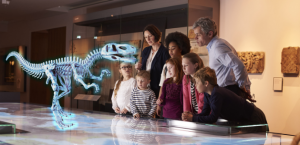
Improvement with technological advancement
For creativity purpose, different museums are using AR technology. The result for implementing AR in museums gives a magical experience to the visitors. They get 3D experience and objects move in the museum galleries (Palladino, 2017; The Franklin University, 2018). Visitors explore a variety of animations such as in The Franklin Institute statues of the first emperor have been placed. It showcases the statues that feel like, are moving in real (Pew Center of Arts, 2018). Visitors share their experience and thus museum gets more of the customers’ visits. Customers get the outstanding experience of moving objects in 3 dimensions.
The use of AR is in a different form in the National Museum of African American History and Culture. With the different application of AR, named Washington Post, the museum is giving an amazing experience because the structure of the museum is based on the different theme created with AR. Moreover, visitors can use this application to understand history as well as critique attached to it (Kennicott, 2017). With this advancement, the museum has been successful to attract a diversified segment of customers and engaged international as well as the multicultural audience (Williams, Page-Kirby, 2018).
Operations of AR in the Targeted sectors
The above section has explained the use of AR creations in different museums of the world. The AR technology will be sold to the museums because it is useful for this industry. It is also useful for the Victoria and Albert Museum in a very different way. In Victoria and Albert Museum, there is the need for advancement. This technology will give a different way of exploring the digital experience to the visitors. The visitors will get the experience of Speaking Celt using AR technology in the Victoria and Albert Museum. This is a very different kind of experience for the natives as well as international tourists. Speaking Celts is amazing for the visitors when they found objects in the museum in a very creative way. The animated avatar of the museum will be moving with the effects of 3D and tell stories related to the history of displaying the avatar. This is very much informative for the children as well as for the different age people. Moreover, the story is told in the first person voice (Breuss-Schneeweis, 2016).
Student’s experience
World Travel Market (WTM) supports new business ideas. It provides opportunities to the start-up for the growth and development of the global travel industry (Battour et al, 2012). WTM organizes events in which an individual gets entrance with the idea of different technologies. It is a great opportunity for individuals to present their unique ideas that support the global tourism industry. It is also beneficial for the students to approach WTM and present their creative ideas for the global tourism industry. The museum is one of the important parts of the tourism industry. Nowadays, museums are attracting customers using state of the art technologies. These technologies attract visitors and also tourists are encouraged to visit several places due to the adorable experience of the museums (Dunleavy and Dede, 2014).
I have also approached WTM through the website of WTM. They select my idea and ask me the required details regarding its real implication in the decided sector. Hence, I provided the required information to them. They sent me a confirmation email after confirmation and sent me an invitation to attend the event. The event was arranged in WTM Global stage. The purpose of this event is to encourage individuals with their creative ideas who have a passion to get a boom through this event. I also share information about my product in this event. Furthermore, owners appreciated my idea of AR. The idea of AR then selected for the museum among different kind of industries. It is necessary to promote our product according to the need of museums.
Conclusion
The above report has highlighted start-up details of the initial entrepreneur. The report has discussed use of technology in the tourism industry. Moreover, it has analyzed what can be the best idea for a different kind of industry. Hence, Augmented Reality (AR) has selected for the Museums. The target segment of the museum has identified in this report. People of every age like to visit the museum but children and aged people are most of the visitors to the museum. Businessmen also like to visit museums when they come with their families. People who have some relatives in the other region they also like to visit several places, hence, if they hear about an amazing place to visit they like to visit the place. The museums include different objects that attract natives as well as foreigners. Today websites are the best source which provides information to the people in the faraway region. Hence, Museums such as the Victoria and Albert Museum and other museums have selected for implementing AR technology; they can promote advancement of museum using websites. People would like to visit the museum due to the attractiveness of it.
References
Ament, S. 2013. Segmentation in action at the Natural History Museum. Retrieved from CultureHive: <http://www.culturehive.co.uk/resources/segmentation-in-action-at-the-natural-history-museum/> [Accessed on November 27]
Battour, M.M., Battor, M.M. and Ismail, M., 2012. The mediating role of tourist satisfaction: A study of Muslim tourists in Malaysia. Journal of Travel & Tourism Marketing, 29(3), pp.279-297.
Breuss-Schneeweis, P., 2016, September. The speaking celt: Augmented reality avatars guide through a museum--case study. In Proceedings of the 2016 ACM International Joint Conference on Pervasive and Ubiquitous Computing: Adjunct (pp. 1484-1491). ACM.
Brida, J.G., Disegna, M. and Scuderi, R., 2013. Visitors of two types of museums: A segmentation study. Expert Systems with Applications, 40(6), pp.2224-2232.
Chen, X., Xu, L., Wang, Y., Wang, H., Wang, F., Zeng, X., Wang, Q. and Egger, J., 2015. Development of a surgical navigation system based on augmented reality using an optical see-through head-mounted display. Journal of biomedical informatics, 55, pp.124-131.
Chung, N., Han, H. and Joun, Y., 2015. Tourists’ intention to visit a destination: The role of augmented reality (AR) application for a heritage site. Computers in Human Behavior, 50, pp.588-599.
Ciecko, B. 2018. Museums are the best place to find innovation in AR. Retrieved from Venture beat: <https://venturebeat.com/2018/03/27/museums-are-the-best-place-to-find-innovation-in-ar/> [Accessed on November 27, 2018]
Dunleavy, M. and Dede, C., 2014. Augmented reality teaching and learning. In Handbook of research on educational communications and technology (pp. 735-745). Springer, New York, NY.
He, Z., Wu, L. and Li, X.R., 2018. When art meets tech: The role of augmented reality in enhancing museum experiences and purchase intentions. Tourism Management, 68, pp.127-139.
Hsiao, H.S., Chang, C.S., Lin, C.Y. and Wang, Y.Z., 2016. Weather observers: a manipulative augmented reality system for weather simulations at home, in the classroom, and at a museum. Interactive Learning Environments, 24(1), pp.205-223.
Jorner, J. 2017. How Augmented Reality Is Creating a New Target Market on Social Media. Retrieved from Adweek: <https://www.adweek.com/digital/james-jorner-effective-inbound-marketing-guest-post-augmented-reality/> [Accessed on November 27]
Jung, T., tom Dieck, M.C., Lee, H. and Chung, N., 2016. Effects of virtual reality and augmented reality on visitor experiences in museum. In Information and Communication Technologies in Tourism 2016 (pp. 621-635). Springer, Cham.
Kennicott, P. 2017. The African American Museum a year later: Still the hottest ticket in town. Retrieved from The Washington Post: <https://www.washingtonpost.com/entertainment/museums/the-african-american-museum-a-year-later-still-the-hottest-ticket-in-town/2017/09/22/15aa027e-8cf4-11e7-84c0-02cc069f2c37_story.html?noredirect=on&utm_term=.7ae18179c1f5> [Accessed on November 27]
McIntyre, H. M. 2013. Culture segments in action: British Museum case study. Retrieved from CultureHive: <http://www.culturehive.co.uk/resources/visual-arts-marketing-case-study/> [Accessed on November 27]
Museum Association, 2018. About. Retrieved from Museum Association: <https://www.museumsassociation.org/about/frequently-asked-questions> [Accessed on November 27]
Museum Next, 2018. Creating a buzz marketing The British Museum. Retrieved from Museum Next: <https://www.museumnext.com/insight/creating-buzz-marketing-british-museum/> [Accessed on November 25]
Palladino, T., 2017. Terracotta Warriors Receive Augmented Reality Treatment from the Franklin Institute. Retrieved from New Reality: <https://next.reality.news/news/terracotta-warriors-receive-augmented-reality-treatment-from-franklin-institute-0179674/> [Accessed on November 26]
Pew Center of Arts, 2018. Enhancing Views of History: Terracotta Warriors and Augmented Reality. Retrieved from Pew Center of Arts: <https://www.pewcenterarts.org/grant/enhancing-views-history-terracotta-warriors-and-augmented-reality> [Accessed on November 26]
Rauschnabel, P.A. and Ro, Y.K., 2016. Augmented reality smart glasses: An investigation of technology acceptance drivers. International Journal of Technology Marketing, 11(2), pp.123-148.
The Franklin University, 2018. Terracotta Warriors of the first emperor. Retrieved from The Franklin University: <https://www.fi.edu/exhibit/terracotta-warriors> [Accessed on November 26]
Wang, C.S., Hung, S.H. and Chiang, D.J., 2017, May. A markerless augmented reality mobile navigation system with multiple targets display function. In Applied System Innovation (ICASI), 2017 International Conference on (pp. 408-411). IEEE.
Williams, S. Page-Kirby, K. 2018. Smithsonian’s new film festival offers opportunity — and hope — to filmmakers of color. Retrieved from The Washington Post: <https://www.washingtonpost.com/express/2018/10/18/smithsonians-inaugural-african-american-film-festival-offers-opportunity-hope-filmmakers-color/?utm_term=.7aba6c8e6257> [Accessed on November 27]
Zhou, M. and Teo, T., 2017. Exploring Student Voice in Teachers' Motivation to Use ICT in Higher Education: Qualitative Evidence from a Developing Country. International Journal of Educational Technology, 4(1), pp.26-33.
Get 3+ Free Dissertation Topics within 24 hours?

















